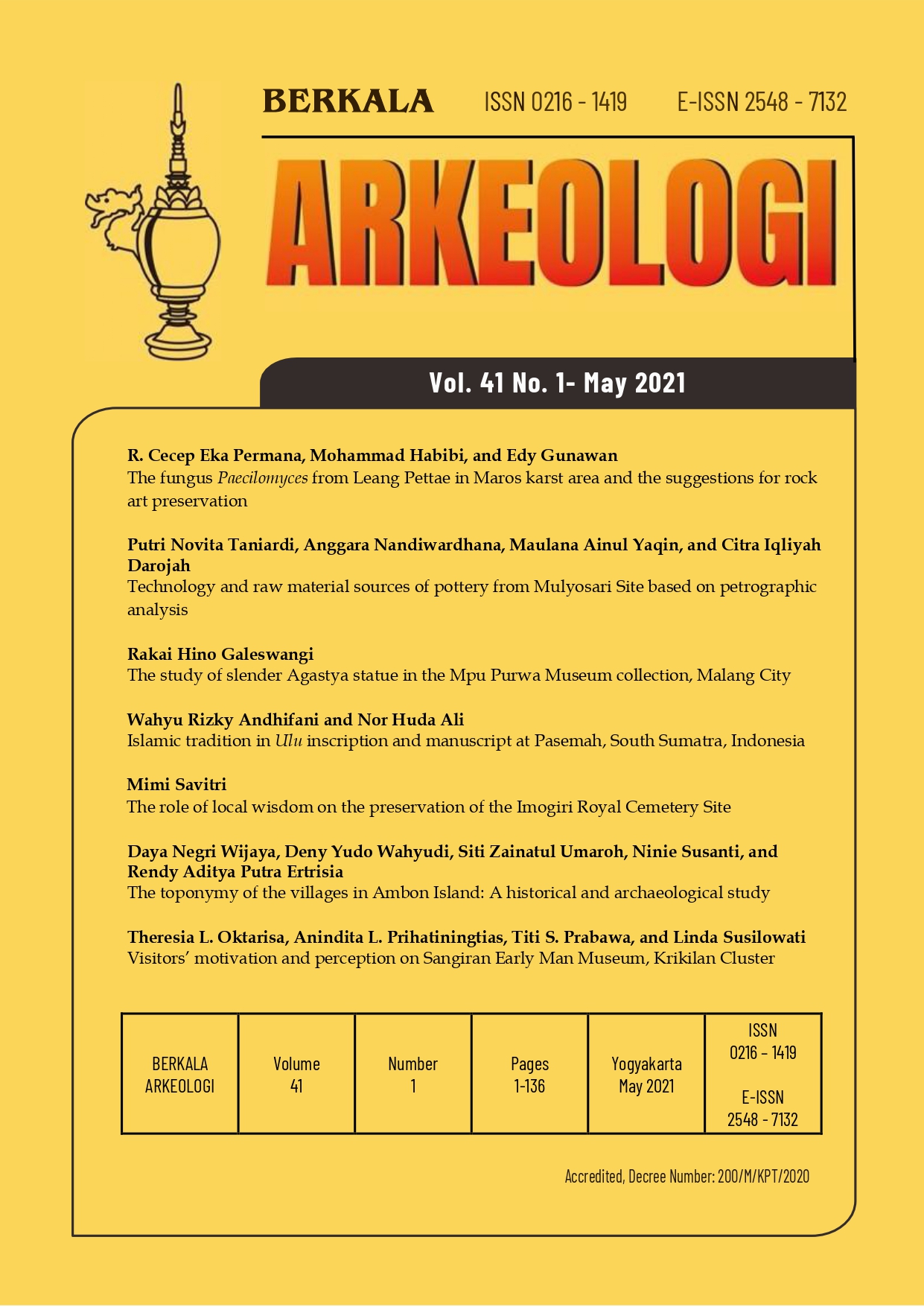Technology and raw material sources of pottery from Mulyosari Site based on petrographic analysis Teknologi dan sumber bahan gerabah Situs Mulyosari berdasarkan analisis petrografi
Main Article Content
Abstract
Since the research in 2018 until 2019, pottery sherds are the most dominant artifact from Mulyosari megalithic site amongst other. Hence, analysis conducted towards pottery directly associated with the megaliths are important. Petrographic analysis that was applied in this research is aiming to understand the technology and the material source of pottery at Mulyosari Site. It is necessary to know whether the pottery is locally made or imported from other region. Petrographic analyses were carried out to several excavated pottery samples. All the samples were not randomly chosen; instead they were based on specific character of pottery sherds. The result of analysis shows that the source of pottery material located within geological formation of researched area comprises Sukamade, Merubetiri, Batu Ampar, and Merubetiri limestone. The result of analysis also shows advanced pottery making technology using spinning wheel and open firing at 400 Celsius degrees.
Article Details

This work is licensed under a Creative Commons Attribution-NonCommercial-ShareAlike 4.0 International License.
References
Atmosudiro, S. (1984). Studies on ceramics, notes on the tradition of pottery making in the Region of Kasongan, Regency of Bantul, Yogyakarta. Pusat Penelitian Arkeologi Nasional, Proyek Penelitian Purbakala, Departemen P dan K.
Barker, A. (2014). A key for identification of rock-forming minerals in thin-section. Taylor and Francis Group.
Bemmelen, R. W. Van. (1949). The geology of Indonesia vol. II: general geology of Indonesia and adjacent archipelagoes.
Department of Archaeology University of York. (2000). Petrology glossary. Internet Archaeology 9. https://intarch.ac.uk/journal/issue9/glossary.htm#Temper
Fatmarani, S. (2016). Analisis daerah asal gerabah di Situs Topo dan Mareku, Pulau Tidore, Maluku Utara berdasarkan analisis bentuk, hiasan dan petrografi. Gadjah Mada.
Gede, I. D. K. (2013). Misba dalam masyarakat Alor: kajian bentuk dan fungsi. Forum Arkeologi, 26(3), 181–194.
Kasnowihardjo, G. (2012). Teknologi gerabah Situs Ranu Bethok dan Ranu Grati: “sebuah kajian berdasarkan analisis petrografi.” Berkala Arkeologi, 32(2), 109–124. https://doi.org/10.30883/jba.v32i2.51
Kusumawati, A. (2011). Kemajemukan tradisi megalitik di Indonesia. Forum Arkeologi, 24(3), 211–223. https://doi.org/10.24832/fa.v24i3.299
Mahirta. (2003). Human occupation on Rote and Sawu Islands, Nusa Tenggara Timur. Australian National University.
Mc Kinnon, E. E. (1996). Buku panduan keramik.
Nandiwardhana, A. (2017). Analisis teknologi dan petrografi gerabah pada Situs Tron Bon Lei, Desa Lerabaing, dan Gua Tabubung di Pulau Alor. Universitas Gadjah Mada.
Orton, C., Tyers, P., & Vince, A. (1993). Pottery in archaeology. Cambridge University Press.
Ownby, M. F., Giomi, E., & Williams, G. (2017). Glazed ware from here and there: Petrographic analysis of the technological transfer of glazing knowledge. Journal of Archaeological Science: Reports, 16, 616–626. https://doi.org/10.1016/j.jasrep.2016.04.019
Quinn, P. S. (2013). Ceramic petrography, the interpretation of archaeological pottery & related artefacts in thin section. Berforts Information Press, Oxford.
Sartohadi, J. (2014). Bentang sumberdaya lahan Kawasan Gunung Ijen dan sekitarnya. Laboratorium Geografi Tanah Fakultas Geografi. UGM.
Solheim, W. G. I. (1990). Earthenware pottery, the T’ai and the Malay. Asian Perspective, 29(1), 25. https://www.semanticscholar.org/paper/Earthenware-Pottery%2C-the-T%27ai-and-the-Malay-Solheim/ae5602deba4b3085a39cd0181e30f9d6aa667941
Taniardi, P. N., Alifah, Wibowo, H., Purnamasari, R., Darojah, C. I., Yaqin, M. A., Saputro, B. I., Wibisono, M. W., Fuadillah, G. A., Mudjiono, & Asmaranatha, P. B. A. (2019). Laporan Penelitian Arkeologi: Budaya megalitik di Banyuwangi dalam konteks persebaran budaya megalitik Jawa Timur.

